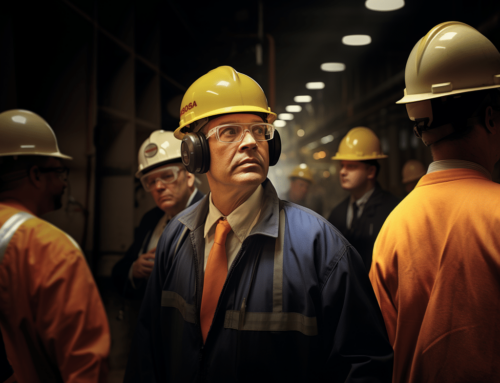Understanding the Role of NIOSH and CAOHC in Advancing Respiratory Protection
The importance of respiratory protection in industrial environments cannot be overstated.
Both the National Institute for Occupational Safety and Health (NIOSH) and the Council for Accreditation in Occupational Hearing Conservation (CAOHC) play crucial roles in setting standards and guidelines for safeguarding worker health.
This piece takes a closer look at the missions of these two organizations, particularly relating to their impact on respiratory health.
Keep reading to discover the latest research from NIOSH and how CAOHC’s standards are shaping respiratory protection measures.
Key Takeaways
- NIOSH and CAOHC Are Key Organizations in Promoting Safety in the Workplace, With NIOSH Focusing on Respiratory Protection and CAOHC on Hearing Conservation
- Workers Should Actively Engage With Hazard Communication Materials Provided by NIOSH and CAOHC to Ensure Proper Utilization of Safety Measures
- NIOSH Conducts Research to Prevent Work-Related Diseases and Injuries, While CAOHC Focuses on Developing and Promoting Safety Standards for Auditory Protection
- The Efforts of NIOSH and CAOHC Contribute to a Comprehensive Approach to Occupational Safety, Emphasizing Both Respiratory and Auditory Protection
- Awareness of Auditory Hazards Can Lead to Improved Vigilance Against Respiratory Threats, Making Adherence to CAOHC Standards Indirectly Beneficial for Respiratory Protection
Introduction to NIOSH and CAOHC
The National Institute for Occupational Safety and Health (NIOSH) and the Council for the Accreditation of Occupational Hearing Conservation (CAOHC) play key roles in promoting safety in the workplace. Primarily, these bodies ensure the application of engineering controls that mitigate risks related to respiratory and auditory hazards, including noise control and contaminant reduction.
A critical part of NIOSH’s work involves strengthening the use of equipment like face masks, respirators, and facepieces, which are essential for respiratory protection. On the other hand, CAOHC champions the implementation of standards around hearing conservation, such as the use of hearing protectors, and creating robust hearing conservation programs.
The vigilance of workers plays a significant role in utilizing these safety measures. It’s therefore necessary for one to request access and actively engage with materials on hazard communication offered by both NIOSH and CAOHC.
Through platforms such as Skillsoft, NIOSH and CAOHC can disseminate necessary information to concerned users. Apart from face mask and respirator clearance tests facilitated by TSI, such platforms provide resources on eye protection, scaffolds safety, and hearing conservation among others. By successfully utilizing all this, a comprehensive protection approach can be achieved.
Understanding the Mission of NIOSH
NIOSH, an organization under the U.S Department of Health and Human Services, aims to establish protective standards for occupational safety and health. Fundamentally, the organization’s mission revolves around protecting workers against health hazards by developing new knowledge in the field. By so doing, NIOSH actively contributes to the prevention of work-related illnesses and injuries.
One of NIOSH’s key duties includes conducting research on ways to prevent work-related diseases and injuries. This knowledge generation process often includes the testing of devices such as face masks, respirators, and additional protective equipment. Third-party organizations like TSI offer critical support in testing respirator protection equipment.
Local and international organizations often apply for NIOSH certification for their end products such as facepieces. Once certified, these products stand to benefit from the organization’s endorsement, strengthening their appeal to users:
- Safety harnesses
- Chemical-resistant gloves
- Eye protection equipment
- Face masks and respirators
NIOSH also collaborates with other bodies like the CAOHC in addressing occupational health safety issues. This cooperative approach forms a crucial part of NIOSH’s strategy, reinforcing its dedication towards advancing respiratory protection and workplace health safety. By understanding and valuing NIOSH’s mandate, organizations can ensure access to crucial information and enhance the distribution of reliable and efficient personal protective equipment.
CAOHC’s Role in Advancing Respiratory Protection
While NIOSH’s role is inherently tied to occupational safety and health across industries, CAOHC’s remit is more specialized. The Council is primarily focused on hearing conservation, aiming to prevent hearing loss due to noise or other occupational hazards. To achieve this, CAOHC develops and promotes safety standards in the realm of auditory protection in work environments.
A significant part of CAOHC’s work involves training, certifying, and providing essential resources to hearing conservation professionals. This includes the training of Occupational Hearing Conservationists (OHCs) entrusted with the implementation of hearing conservation programs. Online platforms like Skillsoft considerably facilitate the distribution of these training resources, allowing wide access to its content for interested parties.
CAOHC also ensures that appropriate hearing protectors are used in workplaces to control occupational noise exposure. This forms part of its hearing conservation program, which includes a range of measures to protect employee hearing as follows:
- Noise monitoring
- Hearing testing
- Hearing protectors
- Employee training and education
- Program evaluation
Despite its primary focus on hearing conservation, CAOHC’s efforts contribute to the cause of respiratory protection. By working in tandem with NIOSH, and linking its hearing conservation practices with the respiratory and other health and safety protocols prescribed by NIOSH, CAOHC helps establish a comprehensive safety network that emphasizes both respiratory and auditory protection.
Key NIOSH Research Related to Respiratory Health
NIOSH invests significantly in research aimed at enhancing the understanding and treatment of respiratory health issues. This research often targets improving the functionality and effectiveness of respiratory protective equipment. It is through such research that innovations in occupational safety, such as the development of more efficient respirators and masks, are realized.
One of the critical research areas for NIOSH is studying the role of contaminants in respiratory health. Contaminants, which can be inhaled during work tasks, pose a significant threat to respiratory health, hence their study being a top priority. Efforts to find ways of reducing workplace contaminants and reducing their impact on workers’ respiratory health have been remarkably successful in the past.
Another significant part of NIOSH’s research is on engineering controls. Engineering controls aim to eliminate or reduce worker exposures to hazards, and NIOSH’s research greatly influences the implementation of such measures. This research generally targets the following areas:
- Noise control
- Respiratory protection
- Structural safety (scaffolds)
- Efficiency of protective clothing
A comprehensive approach to occupational safety necessitates the acknowledgment of the inter-play between different risk factors. Hence, NIOSH’s research also considers how auditory protection — a concern typically associated with CAOHC — could bear impact on respiratory health. By demonstrating a commitment to multi-disciplinary research, NIOSH continues its quest towards improving respiratory health and safety in workplaces.
How CAOHC Standards Influence Respiratory Protection Measures
While CAOHC is primarily known for its work in hearing conservation, its influence also extends to respiratory protection measures. The connection between the two areas often arises due to shared working environments where both respiratory and hearing protections are necessary. As such, the implementation of CAOHC standards can influence the adoption of respiratory protection measures considerably.
Several of the CAOHC’s practices that directly impact effective respirator usage involve raising awareness of the potential hazards in the workplace. Emphasizing hearing conservation often brings along with it a deeper understanding of the environment and increased awareness of other hazards such as respiratory threats. This insight is crucial in encouraging workers to take appropriate steps for their respiratory protection.
For instance, a hearing conservation program following CAOHC guidelines can encompass various crucial elements, including:
- Training and education of staff
- Regular monitoring and assessment of noise levels
- Selecting and fitting hearing protectors
- Audiometric testing
When these elements are robustly implemented, they can foster a broader culture of safety within the organization that goes beyond hearing conservation. By promoting good safety habits, encouraging the use of engineering controls, and instilling respect for hazard communication, adhering to CAOHC standards indirectly propels better respiratory protection measures in the workplace.
Comparison: NIOSH and CAOHC’s Approach Towards Respiratory Health Protection
NIOSH and CAOHC, while both focused on creating a safer work environment, approach respiratory health protection from different angles. NIOSH, as a broader organization, directly addresses occupational safety and health, including respiratory protection. It conducts extensive research, provides guidelines, and sets standards to safeguard workers from respiratory threats.
CAOHC, on the other hand, takes a more focused approach. While its main mandate is centered on hearing conservation, its practices indirectly influence respiratory health. Greater awareness about auditory hazards can naturally lead to enhanced vigilance against respiratory threats present in the same environment.
Moreover, NIOSH and CAOHC’s partnerships render a more holistic approach to occupational safety. While NIOSH recommends the use of certain facepieces or respirators, CAOHC’s training programs educate on the necessity of such protective gear, facilitating their adoption.
The combined efforts of NIOSH and CAOHC have resulted in a comprehensive approach to worker safety. By bridging the gap between hearing and respiratory protection, they have created a healthier and safer environment for workers across numerous industries.







